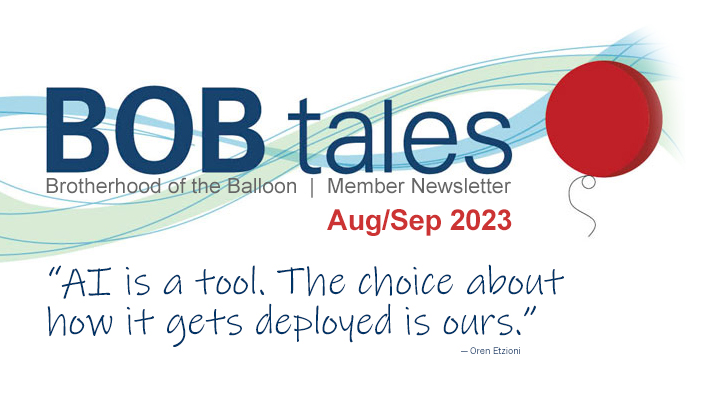
Dear Members (a note from Deb Hickey):
Don’t have anything to do this afternoon? I have 114 videos for you to watch.
---------------------
Last month, I called one of our members, ‘John,’ to thank him for making a contribution to proton research at Loma Linda. And as you may know, when we call to thank each member who makes a gift, we also use it as an opportunity to check on their health, ask about their proton treatment experience, find out if they’re reading and enjoying the newsletter, etc.
In chatting with John, I learned that when he was treated at Loma Linda in 2010, he developed some special relationships with his care team and other staff members, especially Dr. Lynn Martell.
Lynn, now retired, was Director of Special Services and he spent most of his time making everyone around him feel, well, special. If you were lucky enough to be treated at Loma Linda between the late 1990s and 2017, you know what I mean.
“Lynn interviewed me for a TV program,” John said.
I immediately knew what he was talking about because my father and I were also interviewed by Lynn many years ago. “Journey of Hope!” I blurted out excitedly.
“That’s it!”
Shortly after ending my conversation with John, I did a quick Google search and found the old Journey of Hope website. To my surprise, there on the home page was a still image of Lynn interviewing the man himself…
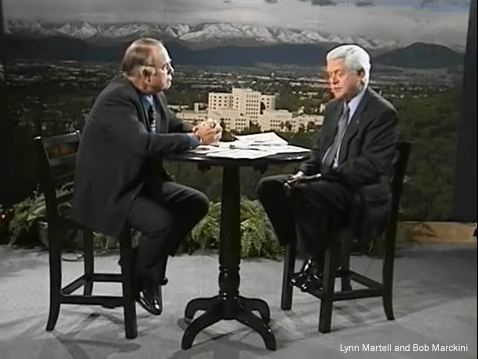
The Journey of Hope program featured inspirational stories mostly of people who’d been confronted with and overcame serious medical challenges. Their experiences and struggles led them through crises and eventually to hope, healing, and wholeness. The program was aired on Loma Linda Broadcasting Network (LLBN), but later moved to Smart LifeStyle TV.
Lynn’s very first interview, which took place some time in 2006, was with Bob Marckini. Lynn asked about his prostate cancer diagnosis and how he found his way to proton therapy, his experience of treatment at Loma Linda in 2000, why he wrote his (first edition) book, why he created the Brotherhood of the Balloon, and why he said that being diagnosed with prostate cancer is the best thing that’s ever happened to him.
I was glad to see Dad’s “silver fox” hairstyle hadn’t changed. Kidding. In all honestly, as I watched him speak and listened to what he had to say, I felt overwhelmingly proud to be a part of what my father has created.
I spent the next three-and-a-half hours combing through the other videos. I couldn’t stop watching. The people Lynn interviewed – a dynamic athlete who had his arm cut off by a cooling tower; a high school student who was confronted with two brain tumors at the base of her brainstem and given four months to live; a bicycle rider who got hit by a pick-up truck, whose life, in a split second, was changed forever; a door-to-door salesman who was involved in a frightening assault by five men in ski masks – they’d been through some of the most horrific and traumatic experiences I’d ever heard, yet they were thankful and deeply impacted by their healing.
Lynn also interviewed several BOB members, as well as some incredibly passionate Loma Linda staff members including Dr. Mark Reeves, radiation oncologist and director of the cancer center.
Even if you weren’t treated at Loma Linda, I encourage you to scroll through some of these videos. The stories are fascinating and the old-school introductory horn music is mesmerizing.
Do not watch video No. 78.
---------------------
We have another fully packed newsletter, and we start with some great news: researchers believe the need for traditional prostate biopsies could be cut in half with the use of MRI for screening and early detection in men with elevated PSA levels. And there’s more good news: a company in California has received FDA approval for an AI technology-based management software system that can identify prostate cancer lesions at a level of accuracy far greater than today’s advanced MRI technology. We also include exciting results from a new study that suggests that following a plant-based diet after a prostate cancer diagnosis may improve patients’ urinary, sexual, and bowel function.
In our Flashback section, read about retired television journalist and former member of the NBC Nightly News team, George Lewis, his prostate cancer diagnosis, and subsequent interview with Bob Marckini in his own backyard. In our Member Spotlight section, meet George Handel who was treated with protons 27 years ago.
Does sugar ‘feed’ cancer? Find out what some experts are saying – especially about the dangers of consuming added sugars. Constipated? There’s a popular breakfast food (which happens to be my favorite) that if eaten regularly, can help soften stool and support regular bowel movements. Sprinkle fresh berries on top and it’s even better.
And, as always, there’s a lot more.
If you have any feedback or suggestions on how to improve the value of the BOB Tales newsletter, please send an email to [email protected]. We appreciate it!
Deb Hickey
One final note: Dr. Martell didn’t stay retired very long. For the past few years, he’s been serving as Pastor of Los Alamitos Seventh-day Adventist church in Los Alamitos, CA.
To print the BOB Tales newsletter or view the newsletter with a larger font size, click here for the PDF file.

- Study: Number of Prostate Biopsies Can Be Cut in Half
- AI-Enabled Focal Treatment of Prostate Cancer on Horizon?
- More Benefits of Plant-based Diet: Better Sexual and Urinary Function
- Proton on the 'Today Show' and 'NBC Nightly News'
- Member Treated 27 Years Ago
- Does Sugar Actually 'Feed' Cancer?
- Popular Breakfast Food Could be Key to Helping You Poop

New Study: Number of Prostate Biopsies Can Be Cut in Half
Let’s face it – prostate biopsies are invasive and unpleasant. Anything that can be done to reduce or eliminate the need for this test would be welcome news for all men.
Since the development of the PSA test about 50 years ago, men with rising PSA typically have been subjected to prostate biopsies to determine if cancer is present. In a large percentage of cases, clinically significant cancer was not detected and the patient was needlessly put through the discomfort – and risks – of a biopsy.
We’ve written before about advances in prostate cancer detection that include utilizing newer, high-resolution MRI imaging, such as the 3-Tesla multi-parametric MRI, which can find suspicious lesions allowing doctors to assign a PIRADS score, which grades these lesions based on the likelihood of clinically significant disease being present.
A July 15, 2023 article in Medscape reported on a study published in The New England Journal of Medicine involving 18,000 men that compared the traditional systemic biopsy to an MRI directed targeted biopsy, which researchers felt would reduce the need for biopsies by half.
Researchers concluded that, “The avoidance of systematic biopsy in favor of MRI-directed targeted biopsy for screening and early detection in persons with elevated PSA levels reduced the risk of overdiagnosis by half at the cost of delaying detection of intermediate-risk tumors in a small proportion of patients.” It should be noted that the clinically significant disease detected in the systemic biopsy group, was of intermediate risk and was low volume disease manageable with active surveillance.
Bottom line: While the MRI-directed targeted biopsy may delay the detection of a small number of intermediate-risk tumors, this advanced imaging technology does detect clinically significant disease and can reduce the number of biopsies by half, saving patients considerable worry and discomfort.
AI-enabled Focal Treatment of Prostate Cancer on the Horizon?
For years doctors and patients alike have visualized a prostate cancer treatment that could be directed at tiny malignant lesions within the prostate, largely leaving the prostate and its ability to function intact. What’s been preventing this from happening has been limitations on the technology that identifies and characterizes cancerous lesions as well as the precision of technologies to focally treat these lesions.
In recent years, focal treatments, such as proton beam therapy, have closed the treatment gap, but precise cancer detection and imaging technologies haven’t been able to produce precise targets. 3-T multiparametric MRI imaging has come a long way in identifying and classifying cancerous lesions within the prostate, but not to the extent that whole gland treatment could be avoided.
Avenda Health, a UCLA spin-off company based in Culver City, CA, recently received FDA approval for an AI technology-based management software system that can identify prostate cancer lesions within the prostate at a level of accuracy far greater than today’s advanced MRI technology. This was recently reported in the Los Angeles Business Journal.
The AI-enabled system Avenda is developing, reportedly can pinpoint the exact location of cancer within the prostate, which will soon allow doctors to zap just the cancer, while leaving healthy tissue within and around the prostate undamaged.
Researchers at Avenda say that after a decade of research, their iQuest AI platform can provide doctors with a three-dimensional image of the cancer that should allow a better understanding of the extent of the disease and the precise location. Armed with this information, a precisely targeted therapy, such as proton beam or focal laser therapy, can be used to destroy the cancer, leaving the bulk of the prostate and surrounding organs intact. Avenda says this technology should better protect the patient’s quality of life, including the preservation of sexual and urinary function.
In summary, in order for physicians to use today’s precision treatment technology to treat prostate cancer focally, they need to know exactly where the cancer is. Avenda says that their new iQuest technology can provide that information. It will be beta-tested in medical centers in the near future and should soon be broadly available.
More Benefits of Plant-based Diet: Better Sexual and Urinary Function
Plant-based diets have many health benefits including a lower risk of prostate cancer progression and recurrence. A new study suggests that following a plant-based diet after diagnosis may also improve patients’ quality of life. This refers to fundamental aspects of living such as urinary, sexual, and bowel function.
At the 2023 American Society of Clinical Oncology (ASCO) Annual Meeting held recently, urologist Stacy Loeb, MD, MSc, PhD (hon), of NYU Langone School of Medicine, presented results based on data from approximately 3,500 men diagnosed with localized prostate cancer.

The first study led by Dr. Loeb on the benefits of eating a plant-based diet was published last year. Results showed that the more plant-based foods consumed, the lower the risk of fatal prostate cancer. And since various other studies have shown plant-based foods to be associated with lower erectile dysfunction, Dr. Loeb wanted to focus on that – as well as other quality of life outcomes that may be connected with prostate cancer treatment – for her latest study.
Results from the most recent study showed small improvements in all functional outcomes, including sexual health, urinary health, bowel health, and hormonal or vitality status in the men who consumed more plant-based foods.
“Although they were small changes, they were statistically significant,” said Dr. Loeb. “And because dietary change is something that’s easy to do, there’s really nothing to lose and everything to gain.”
Dr. Loeb isn’t suggesting patients go strictly vegetarian or vegan. In fact, none of the patients in her study followed a strict vegan diet. She’s simply suggesting that patients eat more plants.
Next, Dr. Loeb and her team plan to look at men who are at higher genetic risk for prostate cancer and whether lifestyle modifications – like eating more plant-based foods – could lower their risk for developing the disease.


We’ve been producing BOB Tales newsletters for more than 20 years. During this time there have been articles that many new members haven’t seen, and some longer-term members may have forgotten. So, we periodically re-run articles from past newsletters. The following is from July 2008.
Proton on the 'Today Show' and 'NBC Nightly News'
George Lewis is a highly respected senior member of the NBC television news team. He’s the winner of three Emmys, the George Foster Peabody and Edward R. Murrow award, and is one of NBC’s most honored correspondents. He’s covered the Iraq war, Desert Storm, the Iran hostage crisis, the Israeli invasion of Lebanon, the Tiananmen Square revolt in China, revolutions in Romania, Latin America and Asia. He covered the O.J. Simpson trials, the Exxon Valdez oil spill, major earthquakes and fires in California, and the Vietnam War. George Lewis is no stranger to crises.
When George was diagnosed with prostate cancer a few months ago, he did his homework. Somewhere along the way, he discovered the BOB website and Bob Marckini’s book. He reached out to Bob and they exchanged several emails and spoke on the phone a few times.
George ultimately decided to have proton treatment at Loma Linda University Cancer Center. And, as you might expect, he had a wonderful experience there, including participating in the Wednesday night meetings and other social programs.
George is doing a story about his prostate cancer journey, and it will be aired on the Today Show and NBC Nightly News within the next few weeks.
As part of this story, George interviewed Dr. Bush and Dr. Martell at LLUCC along with others who were a part of his journey. A couple of weeks ago, he also visited Bob and his wife Pauline at their home along with his producer and a camera crew to film an interview. It was an exciting event in the Marckini’s neighborhood, as the interview was conducted in their backyard with neighbors looking on.
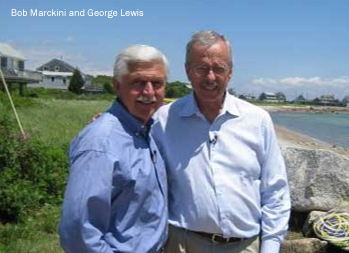
What excites us about this upcoming TV event is that it will bring national attention to prostate cancer awareness and to proton therapy as the treatment of choice for this disease. This kind of attention can stimulate only more interest in proton therapy.

Member Treated 27 Years Ago
You read that correctly – 27 years ago. BOB member George Friedrich Handel (no relation to the German composer) was treated with proton therapy for his prostate cancer in 1996. And you won’t believe how a snowstorm may have been his Divine intervention in finding his way to proton therapy. But let’s start from the beginning…
George was born in Boston in 1940 and spent his childhood about two hours south in Cape Cod, MA. As a young adult, he earned an associate degree in Civil Engineering from Wentworth Institute before transferring to the University of Massachusetts Amherst to receive a bachelor’s degree (some years later he accomplished that).
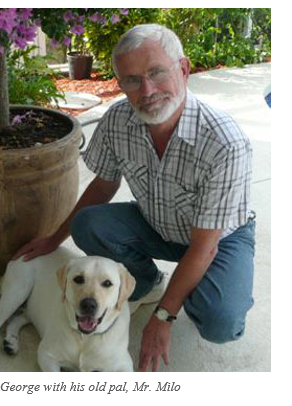
George wasn’t happy at UMass and was considering quitting to accept a Minuteman missile silo engineering job offer in North Dakota. But one day, he walked into the UMass Student Union and met a Navy recruiter who had impressive films of aircraft carrier landings. It looked like a great adventure, and George was intrigued. “I was a restless 21-year-old who couldn’t decide what I wanted to do with my life,” said George.
So, George left UMass and went through the Navy application/admission process at the Naval Air Station (NAS) in South Weymouth, MA. He subsequently reported to NAS Pensacola for flight training on May 2, 1962.
George received his Naval officer commission and wings of gold on April 9, 1964, in New Iberia, LA. He was then assigned for a year to an airborne early warning squadron in Argentia Newfoundland, but that squadron was decommissioned and George was assigned to an airborne intelligence squadron in Rota Spain. That assignment took him to many locations throughout the world, including a stint in Vietnam in an unarmed reconnaissance aircraft. During this time, George was married with two children. And while he loved the Navy, it just didn’t fit his idea of family life, so he left in October 1967.
That November, George joined Northwest Airlines in Minneapolis as a commercial airline pilot. He spent 33 years flying for Northwest and retired in 2000 as a 747-400 captain.
Per FAA regulation as a commercial airline pilot in command, George was required to undergo physicals every six months. After one appointment in the mid-1990s, at age 55, his PSA came back at 9.0. His doctor suggested he have a biopsy (at that time, the only option was a blind biopsy). “I was terrified,” said George. “Because my father died of metastatic prostate cancer.”
After George was diagnosed, he began researching treatment options. He read the book, The Prostate: A Guide for Men and the Women Who Love Them, by Patrick Walsh, the “guru” of radical prostatectomies at Johns Hopkins in Baltimore, MD. He made an appointment with Dr. Walsh, feeling he couldn’t be in better hands. Not surprisingly, George was told that surgery was the way to go, so he scheduled the procedure for Jan. 7, 1996.
During this time, George was undergoing training to fly a Boeing 747-400, a massive international airliner that holds 418 people. It was extremely difficult for him because the training was intensive and George was also distracted by his diagnosis. To complicate matters, he was going through a divorce after 34 years of marriage.
When it rains, it pours.
When the FAA was notified of George’s diagnosis, they informed him he could no longer fly. Grounded, George could only sit at home and wait for surgery, which made the Christmas season tough. But, in mid-December, he received a call from the wife of a pilot buddy. She asked if he’d seen an episode of ABC’s 20/20 about a hospital in Loma Linda, CA, that did a procedure called proton therapy for prostate cancer.
George had done a lot of research, but he hadn’t heard of proton therapy. And as luck would have it, the day before his surgery date at Johns Hopkins, Maryland was buried in 30 inches of snow. Everything was shut down; no planes were flying, and nobody could get in or out of the city.
George rescheduled his appointment for January 31. “And then I sat at home with nothing to do for the next few weeks,” said George. “But then I got an idea.” George knew he could fly to California free because of his career as a captain, so he called LLUCC and set up a consultation.
“Within a couple of weeks, I was in California meeting with a radiation oncologist,” George said. “And I was extremely impressed.” At the same time, he was still skeptical because most men chose surgery to treat their prostate cancer. And why would he have this new type of treatment when he was already scheduled to have surgery by the best surgeon in the business?
George asked his doctor at LLUCC what he could expect for results. “The same as surgery, but with fewer side effects,” his doctor said.
“I really struggled with the decision,” George said. “I flew home and thought about it for a week.”
George started proton therapy on Feb. 2, 1996. During his treatment, he stayed with his son who was living in Palm Springs, about an hour from Loma Linda. In his spare time, George enjoyed working on his son’s pool and landscaping. He dug up most of the backyard and replaced pool equipment, plumbing, and shrubbery.
About six months after George’s proton therapy, his PSA dropped to 1.0. During the following two years, it climbed to 2.3, but then turned around and steadily decreased to where it’s stayed for the past 26-plus years – around 0.3.
Today, George spends his summers in his 300-year-old childhood home in Eastham, MA on the Cape and spends his winters in Florida. He lives with his girlfriend Elaine and their white lab, Sadie.
About 18 years ago, George also built a home in Nova Scotia “from the ground up,” which he’s since sold.
“I don’t exercise,” George admitted. But because his Cape home sits on 12 acres and he spends loads of time working on the house and “playing with” his three tractors and a backhoe, we think his busyness probably makes up for that.
George refers to his time at LLUCC as “an amazing experience.” He says he had no discomfort, no pain, and no side effects. And that snowstorm? “That was Divine intervention,” George said. “I don’t believe I’d have the same results had I underwent surgery.”

More Birthday Letters
As stated in the previous two BOB Tales newsletters, Bob has been overwhelmed with gratitude for the hundreds of cards and letters he received for his 80th birthday from so many members of this group.
For the first few years of the BOB’s existence, essentially all members were Loma Linda proton “graduates.” Certainly, our first couple thousand members call Loma Linda their alma mater. But since then, we’ve welcomed members from every proton center in the U.S. and from just about every center in Europe and Asia.
Many of the cards and letters Bob received came from members representing proton centers from around the world. And he still hasn’t opened all of them, as he limits himself to about 20 per day. “This is the gift that keeps on giving,” Bob says.
Following are excerpts from three letters Bob received. Two represent members who were treated at proton centers other than Loma Linda. One was written by a member’s spouse.
-----------------------
I call this “The Ripple Effect…”
In early 2008, my husband, Charlie, was diagnosed with prostate cancer. By mid-February, he received news that the cancer had not spread. Oh happy day!
One of his best friends, Ralph, had been diagnosed several months earlier and had chosen proton treatment at the University of Florida Proton Center in Jacksonville. Ralph tolerated the treatments very well and had amazing results.
After learning about Ralph’s experience, Charlie bought your book and within days had secured all the necessary medical records to be considered for proton treatment. He was accepted into UFHPTI and completed treatment in July 2008. Another happy day!
Charlie had no major problems in regard to his treatment, and his PSA dropped significantly. Following his proton treatment, we had several more years together. In 2014, after a 10-year battle with congestive heart failure, Charlie passed away.
Here’s the ripple effect: In April 2008, a friend called to ask me to pray for her 13-year-old granddaughter who had a brain tumor. Her daughter and husband had chosen conventional radiation, which would compromise 65 percent of the child’s brain, and treatment was about to begin.
I told her about proton therapy and its advantages. She knew nothing about the proton option.
After much prayer and pleading with her daughter and husband, they finally agreed to allow their daughter to be considered for proton treatment, and eventually made the decision to go in that direction (the oncologist wasn’t pleased with their decision).
On the 21st day of proton treatment, the CAT scan revealed that the tumor was gone, and it never returned!
My friend’s granddaughter went on to graduate from high school and college and is now married. She’s happy and healthy and living life to the fullest.
After our friend’s granddaughter was healed, Charlie said many times that he was thankful he had prostate cancer so that he could tell others about proton therapy. He considered it an honor to have had prostate cancer if it meant preserving the quality of this little girl’s life. And all the people in their family have told us that many generations will benefit from this one event … the ripple effect!
Another gentleman we know, who recently retired from fire rescue, was diagnosed with prostate cancer. We shared proton information with him. He was successfully treated, and he and his wife continue to live a full and happy life many years after his treatment. And they also tell everyone they know about proton therapy. The ripple effect!
I also shared our story with another grandmother who has a 4-year-old granddaughter with a spinal tumor. We’re praying that proton therapy will be the answer for them!
Thank you for sharing your story and writing your book all those years ago. I was given extra years with Charlie and we celebrated our 35th shortly before he passed. I’ve always been thankful that he didn’t have to bear the nasty side effects of conventional treatment or the pain of metastatic prostate cancer.
I pray God will grant you many more happy and healthy birthdays. Please know the impact of your amazing story of survival and hope will continue to affect more people than you can ever imagine. I don’t know if you’re a person of faith, but I believe with all my heart, God used you to spread the message of proton therapy around the world. May God bless you and your family always.

-----------------------
As a fellow engineer, I was particularly impressed with your book and your diligent research. The story about your brother in the opening chapter really stuck with me and I’m so thankful I didn’t go the surgery route being recommended by my doctor (a surgeon). Instead, I selected a proton therapy clinical trial, with hypofractionated pencil-beam scanning, at MD Anderson.
Thank you for sharing my story in the appendix of your second edition. But most of all, thank you for touching so many lives, including mine, with your efforts.
You’re also blessed to have such a loving daughter as Deb and her efforts in your ministry. I couldn’t be more pleased with my results from proton therapy, and I’m now a fellow “apostle” in leading others to it (and to Jesus) – thanks in large part to your book
-----------------------
I was diagnosed with prostate cancer in 2008. I was scheduled for radical prostatectomy and was about to start banking my blood, dreading the deep surgery and all the side effects that would follow.
Then I received a call from my daughter’s father-in-law who’d been watching The Today Show, where an NBC news journalist reported on the proton treatment he’d received at Loma Linda University Cancer Center. He mentioned your book, which I promptly ordered on Amazon. When it arrived, my wife and I immediately read it from cover to cover. We scheduled a consultation at Loma Linda where I learned I was a good candidate for treatment and my Medicare would cover the costs. I canceled my surgery; had proton therapy; and I’ve had 14 wonderful years with no problems. I, too, will be 80 this year, and my wife and I will soon be celebrating our 60th wedding anniversary.
Why Contribute to Research?
You’ve most likely completed your proton treatment and are back to your old routine. So, why contribute to proton research? The most important reason we can think of is to help those behind you – perhaps a family member or a friend who may be diagnosed with cancer and may need a treatment that’s non-invasive and can cure cancer just as well as other treatment options but without the devastating side effects.
Please help researchers who are studying new applications for the proton beam as well as the physicians and scientists who are conducting clinical studies to determine better ways to use proton therapy to benefit more patients. Your gifts allow doctors to use proton technology to treat new cancer sites, new medical conditions, eliminate seizures in children, and even help war veterans by reducing chronic pain.
All of this is being done at Loma Linda University Cancer Center, the first hospital-based proton treatment center in the world. All of the other proton treatment centers wouldn’t be operating without the pioneering work of the late Dr. James Slater, whose determination to improve the quality of life for patients undergoing cancer treatment inspired him to use proton therapy for patient care.
So many struggle to gain access to proton therapy, and at the same time more and more insurance providers are cutting proton therapy from their coverage plans for cost reasons. Yet there’s undeniable proof of the advantages of this precision form of treatment. Research programs and clinical trials need funding to bring the programs to completion; to lower the cost of treatment; and to prove that proton therapy is superior to other forms of radiotherapy.
We charge no dues for membership in our group. Our members repeatedly tell us we provide considerable value to them through the various programs we’ve established over the years, beginning with Bob’s book and including our website, patient testimonials, more than 50 former patient reference lists, medical insurance support, PowerPoint presentation, response to questions/emails/phone calls and especially our comprehensive monthly newsletters with timely information about new developments in prostate cancer prevention, detection, treatment, as well as the latest developments in proton therapy for treating prostate cancer and other diseases.
We don’t benefit from your gifts firsthand, but we’re passionate about improving the use of proton therapy to benefit more people because we’re dedicated to the advancement of this incredible technology and LLUCC is the institution that started it all.
Thank you.

Giving Options
- Online: Donate here. From the pull-down menu, choose where you’d like to direct your gift —1) Proton Research through the James M. Slater Chair, 2) Proton Research through the Robert J. Marckini Chair, or 3) choose “Other” and specify where you’d like your gift directed in the space provided.
- By Check: Make your check out to “LLUCC.” Specify where you’d like to direct your gift in the memo line — 1) Slater Chair, 2) Marckini Chair, 3) Theranostics, or 4) write “unrestricted” so LLUH can use it where it’s needed most. Mail your check to: LLUH, Office of Philanthropy P.O. Box 2000, Loma Linda, CA 92354.
- By Phone: Call Regina Joseph at 909-558-5010.

Does Sugar Actually 'Feed' Cancer?
Does consuming sugary foods “feed” cancer cells, making them grow faster? The “sugar feeds cancer” narrative goes back decades. That’s when German physiologist Dr. Otto Warburg noticed that some cancerous cells consumed more glucose than healthy cells. Shortly after this discovery, some began to believe that low-sugar diets can help cure cancer. And that assumption is still held today.
In fact, recent polls in the U.S. and Europe suggest about a third of cancer patients actively avoid sugar. While some experts say that diets high in added sugars may increase your risk for developing certain cancers over a lifetime, avoiding sugar altogether doesn’t fight existing tumors. “Every cell requires glucose. Our brain requires glucose,” says Philipp Scherer, Ph.D., a diabetes researcher at UT Southwestern Medical Center in Dallas. “Sugar isn’t a carcinogen. There’s no evidence showing that eating sugar will cause cancer itself. Besides, many, many cancers prefer to use fat as their primary energy source, so even the idea that cancers prefer glucose isn’t quite true.”
Still, there’s growing evidence that has linked the overconsumption of added sugars (sugars added during the processing of foods like sugar-sweetened beverages and desserts) to cancer. For example, a 2018 systemic review of nearly 40 earlier studies linked added sugar consumption to an increase in cancer risk.

Research has shown that excessive intake of sugar can cause chronic inflammation. This can damage cells that may then become cancerous, according to Dr. Scherer. Overconsumption of added sugars can also lower immunity, which can cause cancerous cells to spread. Furthermore, excess sugar can change your metabolism, causing obesity and diabetes, conditions known to increase the risk of developing cancer.
If you already have cancer, eliminating sugar doesn’t necessarily slow cancer growth, according to Stacy Shawhan, oncology dietitian and founder of the Greater Cincinnati Oncology Nutrition Collaborative. “By this point, it’s not sugar intake that’s driving cancer growth, but the cancer itself.”
Also, most experts agree that naturally occuring sugars – like those found in fruits and vegetables – are part of a healthful diet. It’s the excess added sugar that’s associated with higher mortality rates in patients with solid tumors like breast, colon, and prostate cancers, according to Natalie Ledesma, oncology dietitian at the UCSF Helen Diller Family Comprehensive Cancer Center. Other cancers may also be impacted, but research on this is limited.
Dr. Santosh Rao, an integrative oncologist at University Hospitals Connor Whole Health in Cleveland, stresses the importance of patients managing their diets without becoming afraid of food. Up to half experience muscle loss as a result of their disease. And sometimes foods that doctors recommend to their patients during treatment – like electrolyte drinks or even potatoes – can contain a lot of sugars.
So what should you eat?
Whether you’re trying to lower your risk for cancer, or you’ve been diagnosed and you’d like to follow a healthful diet, eat plenty of whole fruits and vegetables. Some observational studies suggest the Mediterranean diet – which includes vegetables, fruits, whole grains, nuts, seeds, beans, olive oil, and eggs – may help reduce cancer risk. Pairing carbohydrates with protein, fiber and fat (a dab of peanut butter on an apple slice) prevents spikes in glucose that can, over time, cause damage to organs, nerves, and blood vessels, as well as increase cancer risk.
Ms. Shawhan says it’s okay to have a little added sugar from time to time, but make sure you’re getting your essential nutrients from the rest of your diet. She recommends staying within the World Health Organization’s guidance of six teaspoons of added sugar a day.
As for sugar substitutes like aspartame and saccharin? Research is inconclusive. Experts suggest avoiding them until we learn more.
Popular Breakfast Food Could be Key to Helping You Poop
Constipation is common, and unfortunately, the prevalence of the condition increases with age. About 33 out of 100 adults over the age of 60 experience symptoms. Keeping constipation at bay typically involves eating enough fiber and drinking enough water. If it’s breakfast time in particular, Madelyn LaRouche, RD, recommends grabbing the oatmeal. “Being intentional about including fiber in your diet will help support the GI function and prevent issues like constipation,” she says.
Oats are high in soluble fiber, making oat cereals a good option for softening stool and supporting regular bowel movements. “It’s important to note that drinking adequate fluids is just as important when it comes to preventing constipation, though,” LaRouche says.
What type of oats contains the most fiber?
According to the Mayo Clinic, steel-cut oats – whole, husked oat kernels that have been cut into two to three pinhead-sized pieces with steel blades – contain the highest amount of fiber as they’re the least processed. They take longer to cook, but the result is warm, chewy and nutty. Top with fruit or nuts, and they taste even better. “Adding fruit and nuts to your oatmeal will help boost the fiber content and, therefore, help prevent constipation,” LaRouche says.
How much fiber do you need?
The recommended daily intake of fiber is 21 to 25 grams per day for women and 30 to 38 grams per day for men. And as Dr. LaRouche recommends, it’s also important to drink betweeen eight and 10 glasses of water per day.
So, while oatmeal alone isn’t going to meet your daily fiber needs, it can certainly help meet them. “Whole grains, vegetables, fruits, legumes and nuts/seeds are all great sources of fiber, and eating a variety of these will help support your daily fiber needs,” LaRouche says.

You Can Beat Prostate Cancer: And You Don't Need Surgery to Do It – Second Edition
223 Amazon Reviews
|
Bob's book is still No. 2 on Amazon's list of more than 6,000 books on prostate cancer. Wow! Who would have guessed? There are 223 reader reviews on Amazon. Below is a recent review written by a retired medical doctor from Hawaii: |
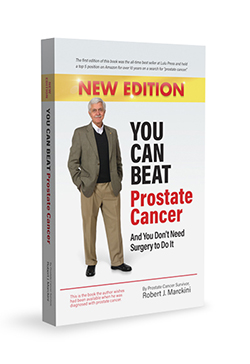 |

A Must-read for Anyone Facing Prostate Cancer
A friend recently loaned me a copy of Robert Marckini’s You Can Beat Prostate Cancer, as I was going through the process of dealing with an elevated PSA, MRI, prostate biopsy, and finally, the diagnosis of prostate cancer.
As a retired anesthesiologist, I found this book to be packed with accurate information, written in language that is concise and easily understood. I strongly recommend this book to anyone facing prostate cancer, and to those who stand by and with them.
This book is written with the layman in mind, but it can also benefit those in the medical profession. Mr. Marckini's passion for proton beam therapy and his desire to share his knowledge with others is evident in his book. I found the information so very helpful as I went through the aforementioned steps, that I am now ready to proceed with my own treatment, and it will be proton beam radiation. In fact, I now own two copies of the new edition, and will share one with a friend recently diagnosed with prostate cancer.
Even though the author is an advocate for proton beam radiation, he presents a fair description of the other modes of therapy for prostate cancer. He includes an extensive list of references to studies and institutions, as well as reviews from former patients who have had proton beam radiation.

Was Bob's Book Helpful to You?
If Bob’s book was helpful to you and you’d like to help others find it on Amazon, please write a review. Book reviews help boost the book’s visibility within Amazon’s search results for users looking for information on prostate cancer treatments and/or proton therapy.
Proceeds from book sales are used to help fund our efforts and to support proton therapy research.

Last Month's Brain Teaser: A Matchstick Puzzle
| Move just two matchsticks to make the dog face to the right instead of to the left. The dog’s tail must stay up. | 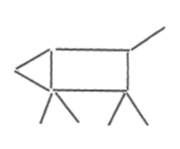 |
Answer:
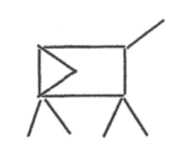
Winner:
Ken Lau of Anaheim, CA is the June/July BOB Tales brain teaser winner. Congratulations, Ken! Your signed copy of Bob’s book is in the mail.

New Brain Teaser
A man got rid of something he'd had for a long time. It was only then that he discovered something he hadn't realized was there. And he didn't like it one bit! What was it?
Hint: He couldn't see it before. Now he really had to face up to it. No, he couldn't just put back what he got rid of.
Send your brain teaser answer to [email protected] for a chance to win a signed copy of Bob Marckini’s NEW second edition book, You Can Beat Prostate Cancer.

Aging
I see people around my age mountain climbing and doing triathlons. I feel good getting my leg through my underwear without losing my balance.

A Crime?
A police officer came to my house and asked me where I was between five and six. He seemed irritated when I answered: “kindergarten.”

Did I read that sign correctly?
Toilet out of order: Please use floor below.
In a laundromat: Automatic Washing Machines: Please remove all your clothes when the light goes out.
In a London department store: Bargain Basement Upstairs
In an office: Would the person who took the step ladder yesterday please bring it back or further steps will be taken.
In an office: After tea break, staff should empty the teapot and stand upside down on the draining board.
Outside a second-hand shop: We exchange anything – bicycles, washing machines, etc. Why not bring your wife along and get a wonderful bargain?
Outside a church: Don’t let worries kill you. Let the Church help!
In front of car wash: Wash & Vacuum Senior Citizens $15.95.
Outside a school playground: No! Dogs Allowed

How do Particle Accelerators Work?
Particle accelerators are machines that propel charged particles (e.g., protons and electrons) to very high speeds and energies, containing them in well-defined beams. When particles collide with targets or other particles, the resulting collisions can release energy, produce nuclear reactions, scatter particles, and produce other particles. The beam of charged particles that’s produced can be used for a variety of research purposes, which are pivotal in various sectors including science, product development, healthcare, and national security.
There are two types of accelerators – linear and circular. Linear accelerators, also known as LINACS, propel particles along a straight beam line toward a fixed target. Circular accelerators propel particles around a ring, constantly gaining speed. Circular accelerators can speed particles up in less overall space than a LINAC, but they’re more complex to build and operate. However, because the particles move in a circle, circular accelerators create many more opportunities for particles to collide. This allows scientists to study those particles and the forces that shape them.
Particle accelerators use electric fields to accelerate and increase the energy of charged particles, which are guided through the accelerating structure by magnetic fields. The beam of particles travels inside a vacuum, which provides an environment that’s free of air and dust in the metal beam pipe.
Electric fields spaced around the accelerator switch from positive to negative at a given frequency. This creates radio waves that accelerate particles in bunches. Particles can be directed at a fixed target, such as a thin piece of metal foil, or two beams of particles can be collided. Particle detectors record and reveal the particles and radiation that are produced by the collision between a beam of particles and the target.
Learn a lot more about particle accelerators and how they’ve contributed to science and improved consumer products. Learn how they’re also used in medical applications, including proton therapy, and how they’ve benefited national security.

Did You Know ...
- Australia is wider than the moon. The moon is 2,113 miles in diameter, while Australia’s diameter from east to west is 2,485 miles.
- Headphones can increase the bacteria in your ears. Wearing headphones for just an hour could increase the bacteria in your ears by 700 times.
- Avocados are not vegetables. They’re fruits because they’re single-seeded berries.
- You probably eat bugs in your sleep. There’s a good chance we’ll swallow 10 spiders and 70 types of insects (or more) during our lifetimes.
- The Eiffel Tower gets taller in the summer. It gets six inches taller due to thermal expansion.
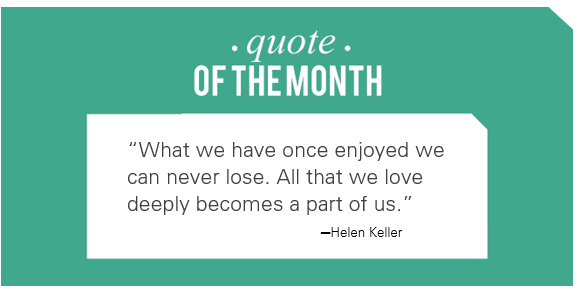

AAADD (Age Activated Attention Deficit Disorder)
This is how it manifests...
It’s time to water my lawn. I turn on the hose in the driveway. I look over at my car and decide it needs washing. As I start toward the garage, I notice there’s mail on the porch table that I brought up from the mailbox earlier. I decide to look through it before washing the car.
I lay my car keys down on the table and go to put the junk mail in the garbage can. I see that the can is full, so I decide to put the mail back on the table and take out the garbage first.
But then I think… Since I’m going to be near the mailbox when I take out the garbage, I may as well pay the bills first. So, I take out my checkbook and see that there’s only one check left.
My extra checks are in my desk drawer in the study, so I go inside the house to my desk. There, I find the can of soda I’d been drinking. I’m going to look for my checks, but first I need to push the can aside so I don’t accidentally knock it over. I feel that the can is getting warm, so I figure I should put it in the refrigerator.
As I head toward the kitchen with the soda, a vase of flowers on the counter catches my eye. The vase needs to be refilled with water. I set the soda can down on the counter and discover my reading glasses that I’ve been searching for all morning. I should put them back on my desk, but first I’m going to refill the flower vase.
I set the glasses back down on the counter, and head over to the sink. On my way there, I spot the TV remote. Someone left it on the kitchen table.
I figure I’ll be looking for that remote tonight when I want to watch TV and I won’t remember it’s on the kitchen table, so I’d better put it back in the living room where it belongs. But first, I’m going to refill the flower vase.
I begin to pour water into the vase, but quite a bit of it spills on the floor. So, I set the remote back down on the table and get some paper towels to wipe up the spill. Then I head down the hall trying to remember what I was planning to do.
At the end of the day, the lawn isn’t watered, the car isn’t washed, and the bills aren’t paid. There’s a warm can of coke sitting on the counter; the flowers are wilted; there’s still only one check in my check book; I can’t find the remote; I can’t find my glasses; I don’t remember what I did with the car keys; and my neighbor called to tell me he turned off the hose that was flooding the driveway.
Then when I try to figure out why nothing got done today, I’m really baffled because I know I was busy and I’m really tired.
Low PSAs to all,
Bob Marckini and Deb Hickey
Click here for the printable PDF version of this newsletter.
NO MEDICAL ADVICE: Material appearing here represents opin1ions offered by non-medically trained laypersons. Comments shown here should NEVER be interpreted as specific medical advice and must be used only as background information when consulting with a qualified medical professional.


